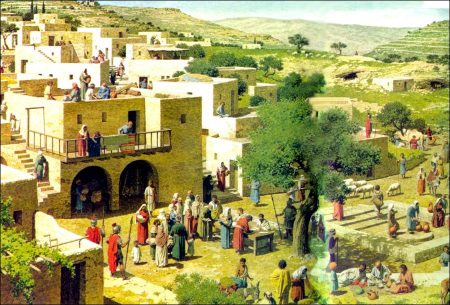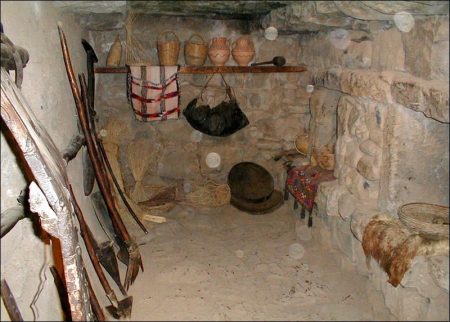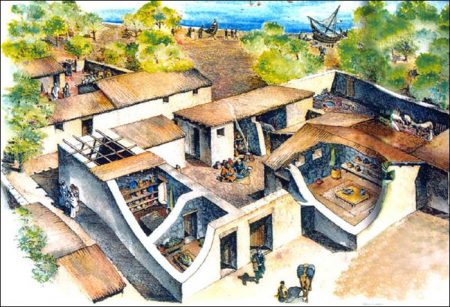Jerusalem’s Terra Sancta Museum, which displays ancient artefacts excavated by the Franciscan Order over the past 100 years, offers insight into life in the Holy Land.
Inside the new archaeological wing of Jerusalem’s Terra Sancta Museum, a hallway leads visitors past a deep water cistern, then becomes a bridge as it passes over an even deeper and older water cistern, built nearly 1,000 years ago. Tucked under a Roman Catholic Franciscan monastery within the walls of the ancient Old City, the museum’s location itself is a journey through the past of both Jerusalem and the religious order dedicated to preserving it.
“This was all filled with dirt,” said museum director and Franciscan friar, Reverend Eugenio Alliata, as he stood on the metal bridge in his brown robe and sandals, overlooking the vast stone cistern below. “We weren’t even sure what was here.” Looking up and continuing to walk, I followed him into a stone room from the 13th Century, likely a workshop used by the Crusaders who ruled the Holy City back then, he explained. This room – now containing an elaborately carved stone that once sat atop a column at one of King Herod’s luxurious palaces in the hills outside Jerusalem – was also, until recently, filled with earth.
But a multi-year restoration project has made this underground labyrinth – built and rebuilt in several layers from the time of King Herod in the 1st Century to the Mamluk sultans in the medieval period – into a museum that tells not only the history of Jerusalem, but also the story of the Franciscan Order’s archaeological discoveries made throughout Israel, the Palestinian territories, Egypt and Jordan over the last century. For more than 100 years, Franciscan friars have carried out dozens of excavations at some of the region’s most famous Christian sites, including in Nazareth, Bethlehem and here in this sprawling Monastery of the Flagellation complex, which has been a pilgrimage site since at least the 4th Century.
“Archaeology is important because it shows us how people lived, and we need that to understand the past, to understand our traditions,” said Alliata, who is also an archaeologist and who excavated some of the displayed items. “Pilgrims and visitors need to see these things.”
But until recently that was not easy. The tens of thousands of artefacts the Franciscans had collected over the years were stored in the adjacent Studium Biblicum Franciscanum, a division of Rome’s Pontifical University devoted to archaeological and Biblical research. Technically making up the city’s oldest archaeological museum, They were only available to the public only by appointment, and most of those who spent time here were scholars.
“It really wasn’t very accessible,” recalled Masha Halevi, who visited the research centre many times while working on her 2010 doctoral thesis in geography at the Hebrew University of Jerusalem and several subsequent academic articles about religious orders and archaeology.
Alliata led me through the museum, past a column intricately carved with doves from a 4th-Century monastery in present-day Jordan, large pieces of colourful mosaic floors from monasteries in the Egyptian desert, and large stone burial coffins marked with crosses. Display cases were filled with ancient coins, including the half-shekels referred to in the Bible; 2,000-year-old grape seeds and olive pits; and utensils, like dishes and cups, used in daily life.
Making these ancient artefacts public in the Terra Sancta Museum archaeology wing, which opened in 2018 and will soon be further expanded, is part of a larger trend of increased public engagement among the Franciscans, who have also recently opened to the public their large library in Jerusalem’s St Saviour’s Monastery and created an online catalogue for it as part of an ongoing effort to renovate various holy sites around the region.
These changes are happening as Israel is experiencing a surge in tourism, with about four million people visiting in 2018, a record high, according to the tourism ministry.
In fact, it was during a previous surge of tourism and interest in the Holy Land in the 19th Century that the Franciscan order began to engage in archaeology.
In the Middle East, this emerging discipline began intensifying and drawing more attention to debates about Biblical history in the late 19th Century. Ultimately, the Franciscans, who had been charged by the Vatican since the 13th Century with guarding Church property and aiding Christian pilgrims in the Holy Land, decided to embrace archaeology and join the growing body of public scholarly discourse about it.
“History finds its safest support in archaeology,” wrote Reverend Prosper Viaud, one of the first Franciscans to participate in an excavation, having dug under the contemporary Shrine of the Annunciation church in Nazareth in 1889. The dig exposed an older structure, which illustrated a long history of devotion at the site. “I set out on this path not because I succumbed to an empty scientific thought, but because of a true will to meet the devotion of the pilgrims and make them know better the church of Nazareth.”
In the early 20th Century, the Franciscans began digging at and around many of their churches and monasteries, publishing books with their results and building a massive library of artefacts in Jerusalem. In 1901 they established their Studium Biblicanum Franciscanum, and since 1924, it has operated uninterrupted as one of a growing number of archaeological research institutions in Jerusalem, including the WF Albright Institute of Archaeological Research, the British School of Archaeology, the Institute of Archaeology at Hebrew University and the École Biblioteque et Archaeologique, established by the Roman Catholic Dominican Order.
The Franciscans’ excavations – from Mount Nebo, the Jordanian mountaintop revered as the place from which Moses first saw the biblical Promised Land; to Caperneum, a town on the Sea of Galilee that contains an ancient synagogue and churches – made important contributions to archaeology in the region. Today many local archaeologists feel indebted to the Franciscans.
“Their research is an important piece of the huge puzzle of archaeology in Israel,” said Dina Avshalom-Gorni, a district archaeologist at the Israel Antiquities Authority who has worked with Franciscan archaeologists at various digs. “Despite their religious beliefs, the research they produce is really pure archaeology. They give us facts and I can trust them.”
For the Franciscans, archaeology remains a valuable tool for engaging the public and helping them understand the context for stories told in the Bible. “You have to know about the daily life to really understand Jesus, to understand the parables,” Alliata explained.
In another room of the museum, Alliata pointed to a glass display case containing vases made from delicate alabaster, considered a luxury item in the ancient world and rare to find intact. He related the Christian Bible story about a poor woman breaking an alabaster vase of perfume on Jesus’ head. Seeing the beautiful and delicate craftsmanship of an alabaster vase highlights the level of generosity and financial sacrifice this woman made for Jesus.
Making his way out of the dim underground archaeological wing, Alliata strolled across a sunny stone courtyard where a tour group was listening to a guide explain how this was the place where Jesus was convicted and handed over to be crucified. Today it is the second of 14 Stations of the Cross along the famous Via Dolorosa, or Way of the Cross, that eventually leads to the Church of the Holy Sepulchre, revered by many Christians as the place where Christ was crucified and entombed.
Not surprisingly, the Franciscans’ excavations often raise more questions than they answer about Biblical events and ancient Jewish and Christian life in the Holy Land. According to Alliata, most Franciscans are looking to learn, rather than to prove particular stories. Holy sites are not abandoned simply because excavations didn’t turn up anything. For example, at the site of the Church of the Nativity in Bethlehem, revered as the place of Jesus’ birth, the oldest excavated artefacts date to the 3rd Century, nearly 200 years after the birth of Jesus.
“We never abandon tradition,” Alliata said. “The stories could be proven or not proven, but religion is based on tradition.”
Views: 1087





